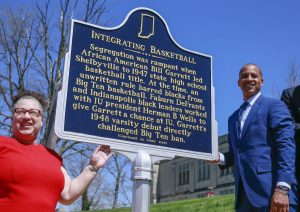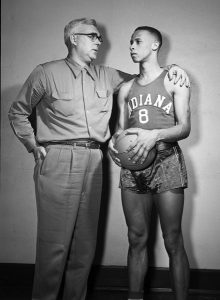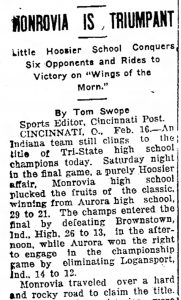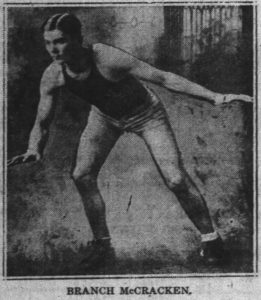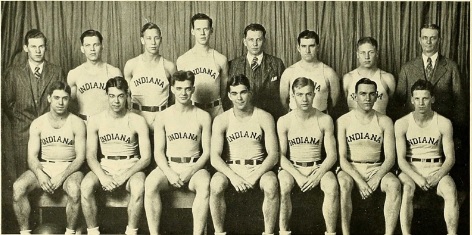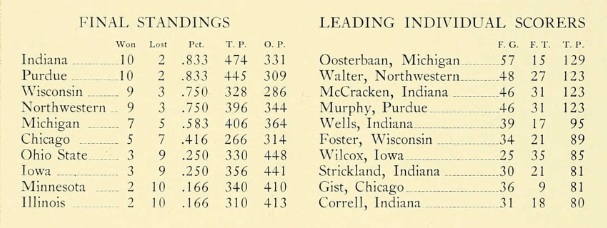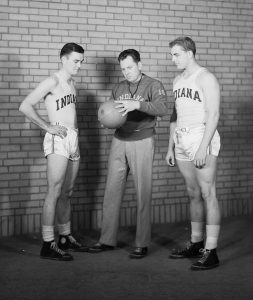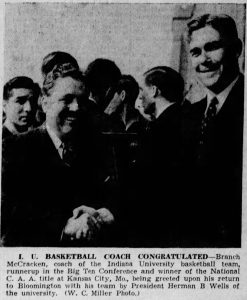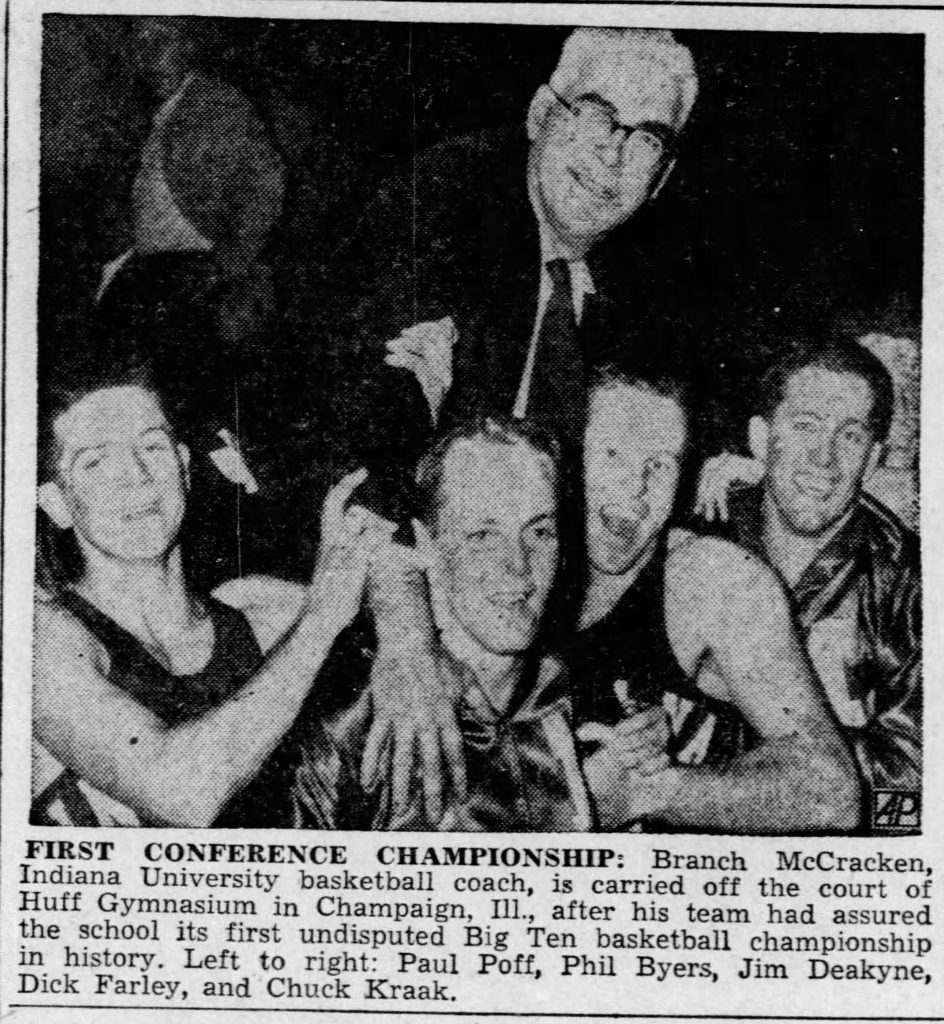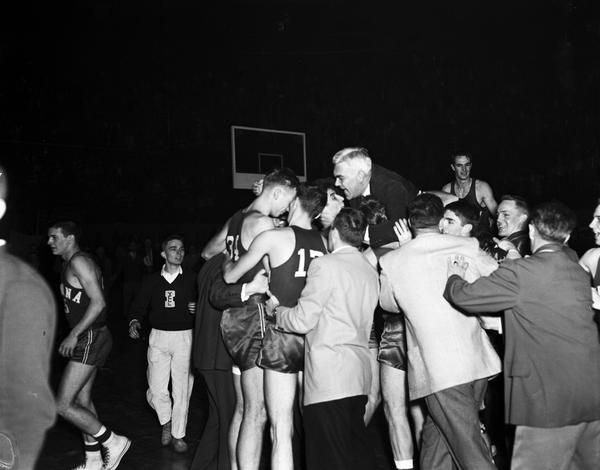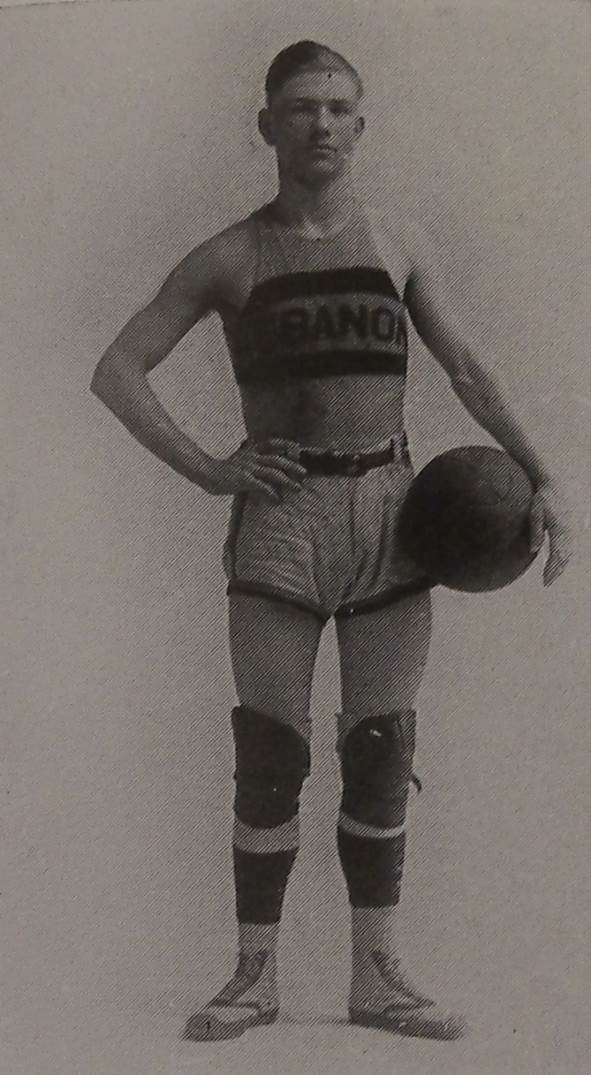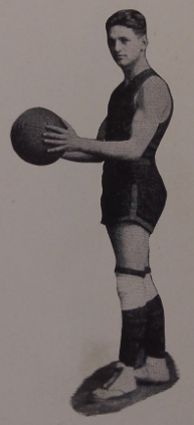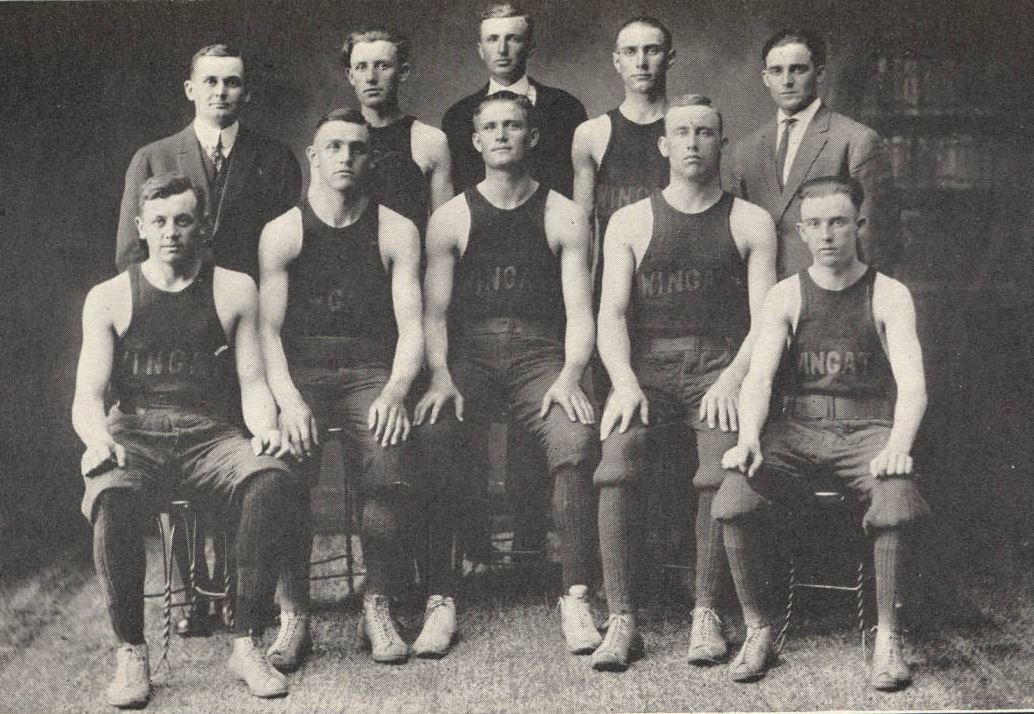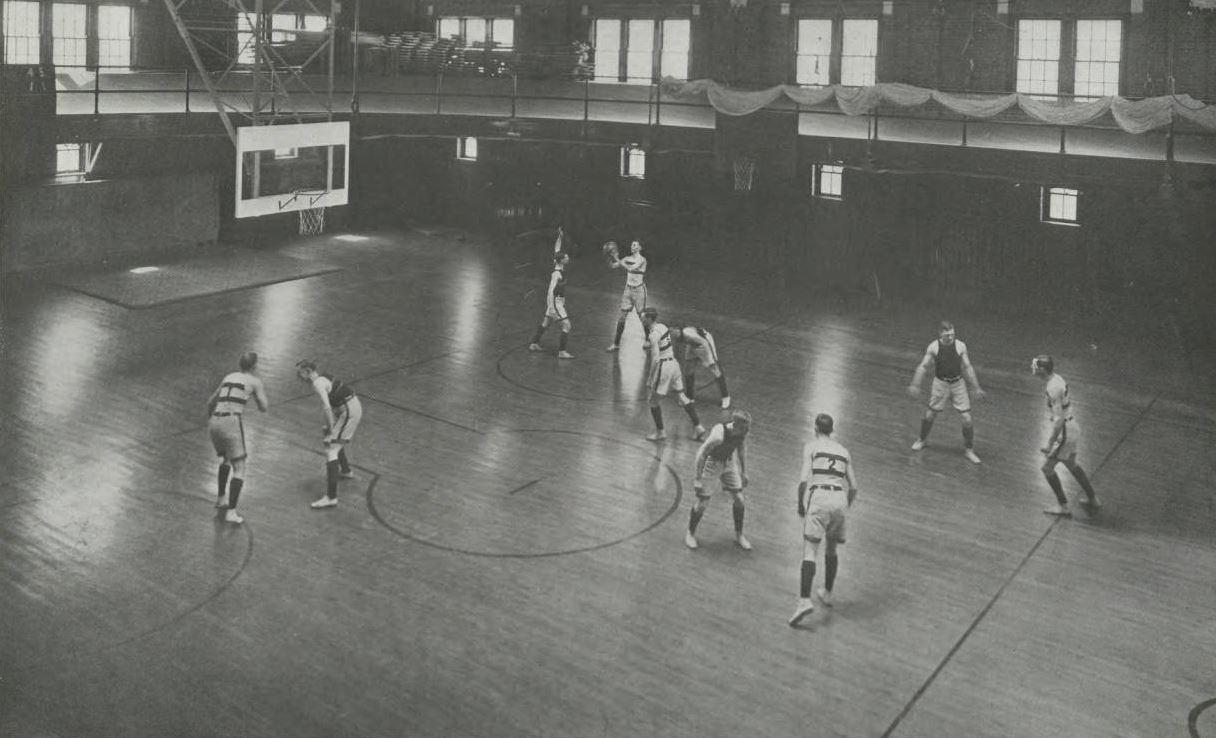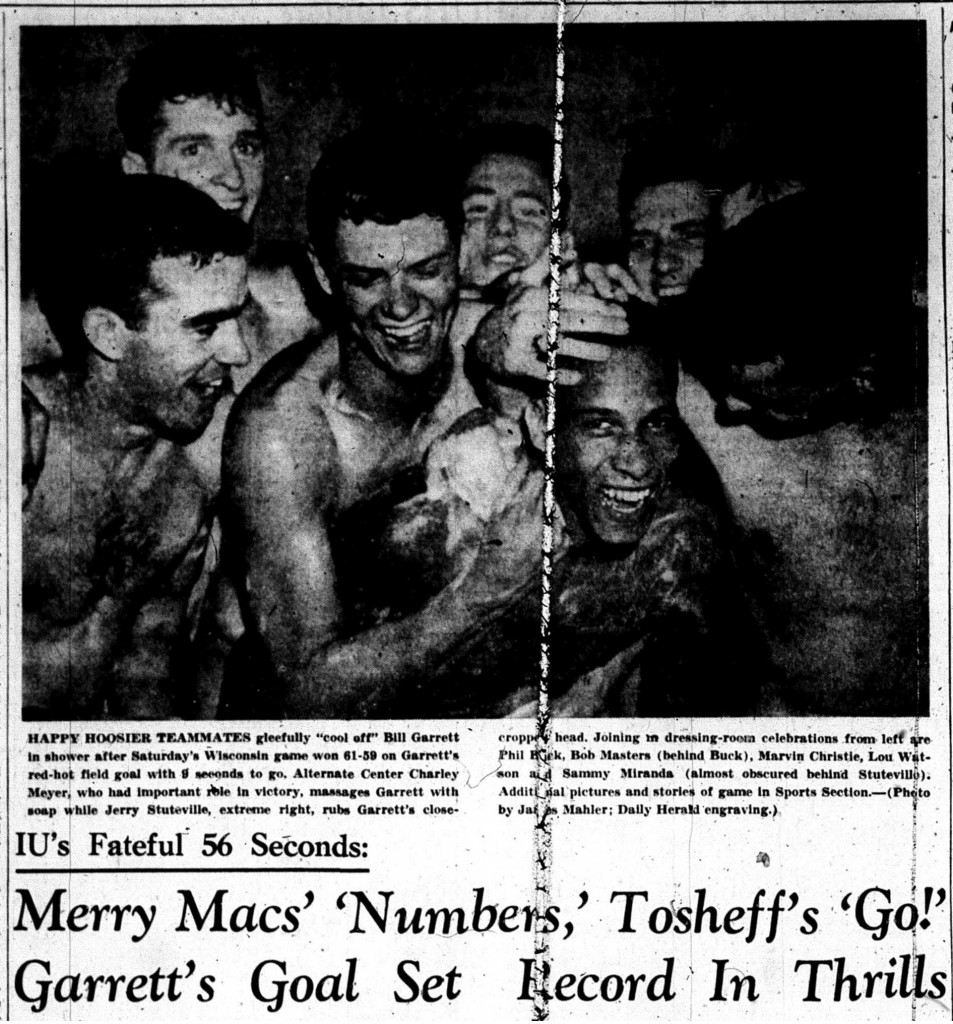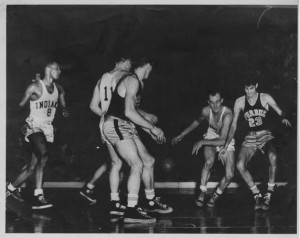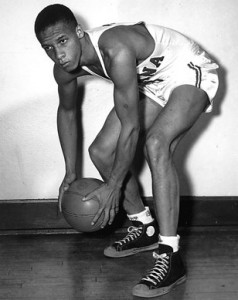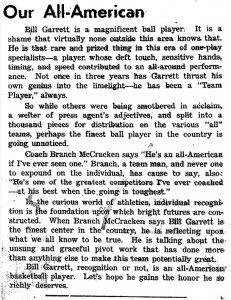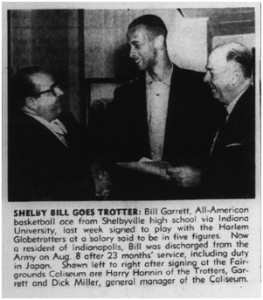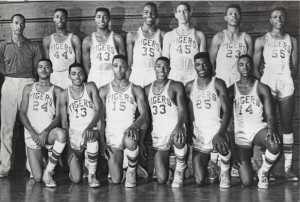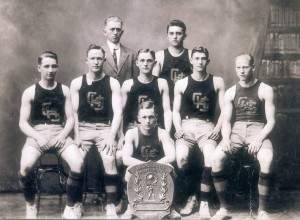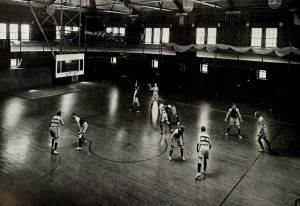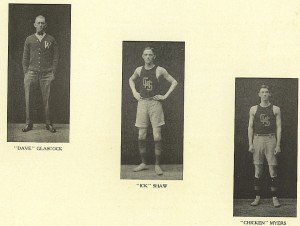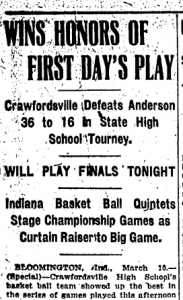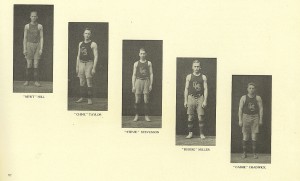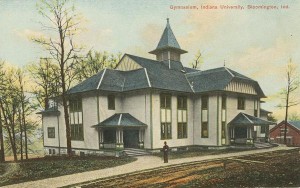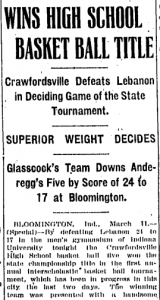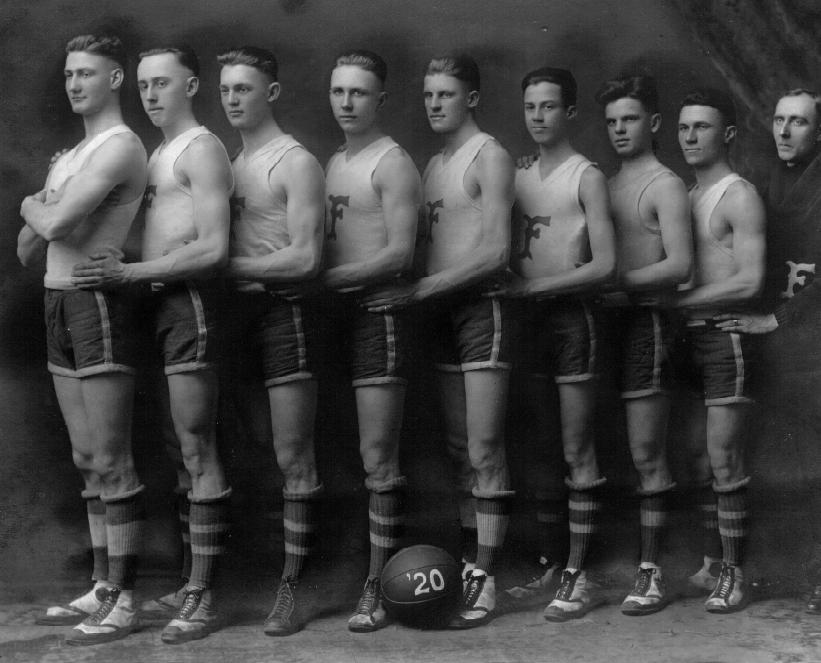
March Madness may not officially start for another week, but here in Indiana it’s already underway. This is the time of year when basketball reigns supreme in the Hoosier state, as fans flock to gymnasiums and arenas to support their high school and college teams and reminisce about the legendary players and moments of the past. This year marks the 110th anniversary of the annual Indiana high school boys basketball tournament (the 109th officially sponsored by the Indiana High School Athletic Association). Throughout its long history, the tournament has given us numerous memories of underdogs defeating giants to claim the state title and bring glory to their towns. Hoosiers will no doubt recall Milan’s 1954 championship, but well before Milan other small schools made their mark on Indiana basketball. The tournament also gave us players like Johnny Wilson and Bill Garrett, who used basketball to overcome racial barriers and help pave the way for others. And it served as a unifying force both at the state level and in small towns across Indiana, creating a shared interest and passion for basketball among Hoosiers. This was certainly the case in the 1920s when the Franklin Wonder Five made their mark on Indiana basketball and established one of the first dynasties in the state’s history.
The Franklin Wonder Five era represented an eight-year period from 1918-1926, wherein Franklin, a small town just twenty miles south of Indianapolis, dominated the state basketball scene. The Wonder Five won an unprecedented three consecutive state championships at the high school level, followed immediately by two state collegiate championships. They were the talk of the town and the target, envy, and dream of many teams across the state and the Midwest. Basketball was already immensely popular in Indiana by this time and the excitement surrounding the sport would later earn the moniker “Hoosier Hysteria.” In Franklin, as in other small towns across Indiana, local residents and businesses rallied closely behind their basketball team. Games were intensely followed by the majority of the community and regular season wins were often celebrated with bonfires and parties in the town square that brought people of all ages and classes together.
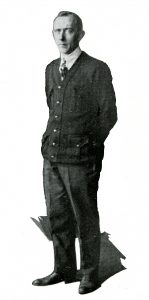
Many of the young men who played during Franklin’s Wonder Five years had grown up playing the game together or competing against one another in grade school. This experience helped them develop a remarkable sense of teamwork once they reached Franklin High School and later Franklin College, which no doubt contributed to their success. It’s important to note that despite their nickname, the Wonder Five comprised more than five young men. That being said, not every player on Franklin’s rosters between the years 1918 and 1926 earned the distinction of being part of the Wonder Five. According to Phillip Ellett, author of The Franklin Wonder Five: A Complete History of the Legendary Basketball Team, Wonder Five teams all featured player Robert “Fuzzy” Vandivier and Coach Ernest “Griz” Wagner. Additionally, “to be considered a member of the Wonder Five, a player must have been on at least one of the three high school state championship teams.” Using this as a benchmark, Ellett identified fourteen players that he considered to be members of the renowned team. [1]

The Wonder Five era began in the fall of 1918, Vandivier’s freshman year and Coach Wagner’s third leading Franklin’s high school squad. The team had a strong season, losing just one game before tournament play. In January 1919, the Indianapolis Star described them as “one of the fastest passing quintets . . . [they] have both speed and stamina, and play a wonderful floor game with a fine degree of team work.” [2] They won the sectional tournament handily, outscoring their four opponents by a total score of 123-34, but fell to Crawfordsville 18-16 in the first round of the state tournament. [3] While the loss no doubt stung, hopes for the future were high. The majority of the team remained intact for the 1919-1920 season and players were eager to improve upon the previous year. They did not disappoint.
As early as November 1919, the Indianapolis News considered Franklin to be a “strong contender” for the state title. [4] They dominated their opponents throughout the season, again losing just one game, to Martinsville, on December 24, 1919. Newspapers frequently commented on their “stonewall defense,” their terrific passing game, their shooting accuracy, and perhaps most importantly, their remarkable sense of teamwork. [5] The team continued its winning ways through sectionals, where they again walloped their opponents by a total score of 174-50. Heading into the state tournament, they were the favorites to win it all. After three big victories, followed by a tight overtime victory over Anderson, Franklin defeated Jefferson High School of Lafayette 31-13 on March 13, 1920 to claim the first state championship for the school and forever cement their name in IHSAA history. [6] The Indianapolis News reported on the celebrations in Franklin in its March 15th issue:
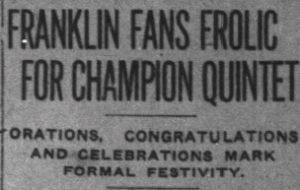
Franklin is hilarious today despite the fact that celebrations have been going on regularly since the results of the final game with Jefferson were flashed over the wires. The official Franklin city celebration did not take place until today. The jubilee started at [one] o’clock this afternoon and was scheduled to last until 6 this evening. A mammoth parade in which all the high school students, the greater part of the Franklin College student body, and hundreds of townspeople participated, was the first thing on the program. – Indianapolis News, March 15, 1920.
In a show of appreciation for leading the team and bringing a championship to the town, Franklin’s residents raised a $1,000 purse, which they presented to Coach Wagner shortly after the tournament. [7] With four of the team’s five starters graduating that spring, leaving only junior “Fuzzy” Vandivier, few could have expected Franklin to claim a second championship in 1921. Little did they know that Franklin’s period of basketball dominance was just beginning.
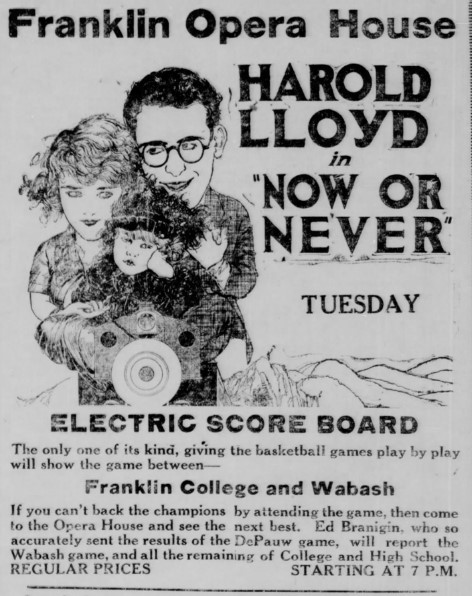
Wagner frequently adjusted his Franklin High lineups early in the 1920-1921 season as he experimented with his new starters. The different combinations proved successful, as Franklin continued to score big wins early in the season. Despite losing four games throughout the year (twice as many as it had in its previous two seasons combined), the team proved that it was again a top contender for the state title. Fans came out in droves to support the team both at home and on the road, with tickets often selling out within minutes. During these years, Franklin alternated between playing their games at the South school gym and Franklin College’s gym, as their gymnasium at the high school was far too small. In December 1920, a new opportunity to follow the team presented itself when the Franklin Opera House placed an electronic score board on its stage. [8] The new scoreboard provided play-by-play coverage of the game for fans. As Ellett notes, “With radio still a novelty and television unheard of,” the electrical scoreboard provided an incredible opportunity for Franklin’s residents to gather together to follow the game “live” with friends and family. Interest in “watching” the game on the scoreboard became so high that its use at the Opera House (and in later years at the Artcraft Theatre as well) became commonplace throughout the Wonder Five years.
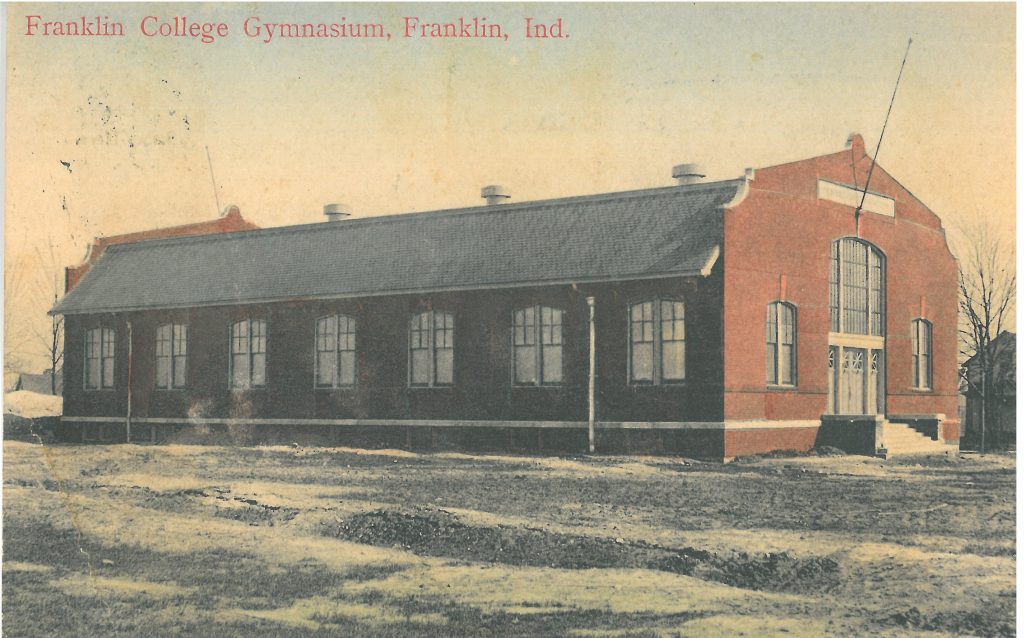
Franklin’s continued success during the 1920-1921 season and its huge following helped underscore the need for a new high school gymnasium that could properly accommodate its fans. As the team prepared for another strong run in the tournament, the Franklin Chamber of Commerce began a season ticket drive for the following year in an effort to help raise the needed funds for construction of a new facility. The drive was successful, as Franklin’s loyal fans purchased 1,000 season tickets, a sign of their faith in and support of the team. [10] It quickly proved to be good investment, as Coach Wagner and his young men again advanced to the state tournament shortly after the drive’s completion.
The team defeated Anderson High School 35-22 on March 19, 1921 in front of more than 10,000 fans at the Coliseum at the Indiana State Fairgrounds for its second consecutive state championship. [11] According to the Richmond Palladium-Item, that evening, “a crowd of about 3,000 persons met the victorious squad at the town square and bonfires were built, yells were given and even the old canon [sic] gave vent to its feelings with an awful roar.” [12] Later that month, the Chamber of Commerce held an official celebration for the team that attracted thousands more. The team had again brought glory to the small town of Franklin.
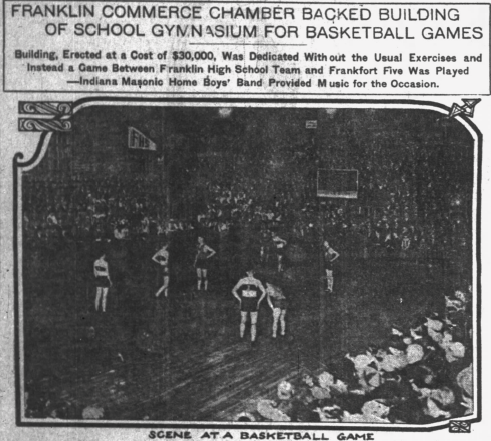
While fans were eager to see the team claim another state title in 1922, they also recognized the enormous difficulty of the task at hand. As the Franklin Evening Star noted on December 3, 1921, “Franklin high school admittedly has the hardest job of any team, for it will have to do the thing that has never yet been done, namely, capturing the state high school championship for three successive years.” [13] Despite a few losses, Franklin had another strong season and looked poised to make another run in the tournament.
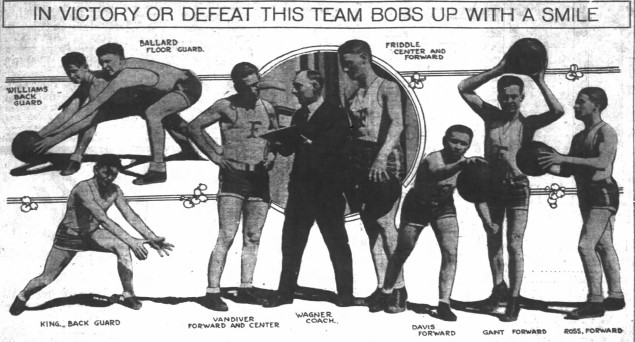
With over 500 teams contending for a chance at the state title that year, the competition was fierce, but Franklin did not let the pressure get to them. On Saturday, March 18, 1922, the team made history when it defeated Terre Haute’s Garfield High School 26-15 for its third consecutive state title. [14] This remarkable feat would not be matched for over sixty years, when Marion won three straight state titles from 1984-1987.
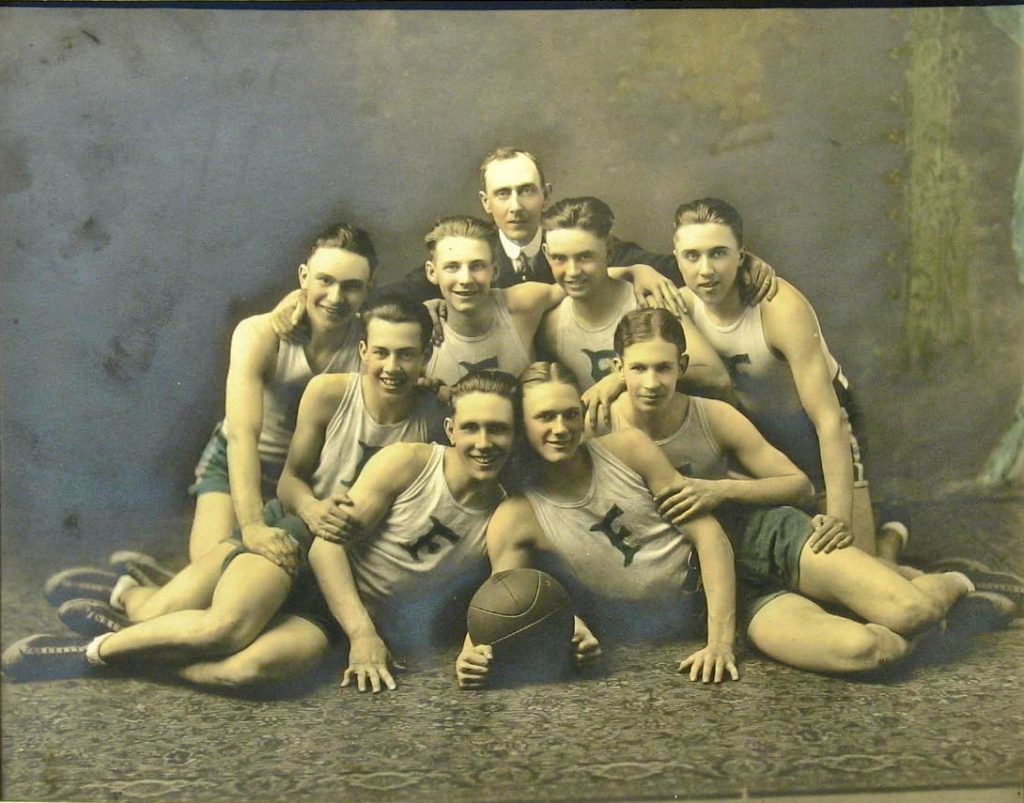
The end of the 1922 season symbolized a changing of the guard for Franklin High School in more ways than one. While the school would experience many other successful basketball seasons in the decades to come, the 1922 state championship was its last. In late April, Coach Wagner became athletic director and basketball coach at Franklin College. Franklin High School graduates Fuzzy Vandivier, John Gant, Carlyle Friddle, and Ike Ballard joined him there that fall in hopes of continuing their reign as champions. Coach Wagner began the 1922-1923 season by alternating between the college’s veteran players and his group of freshmen, but the freshmen quickly claimed the starting roles. As they had in high school, they continued to score impressive wins, drawing attention and praise from across the state.
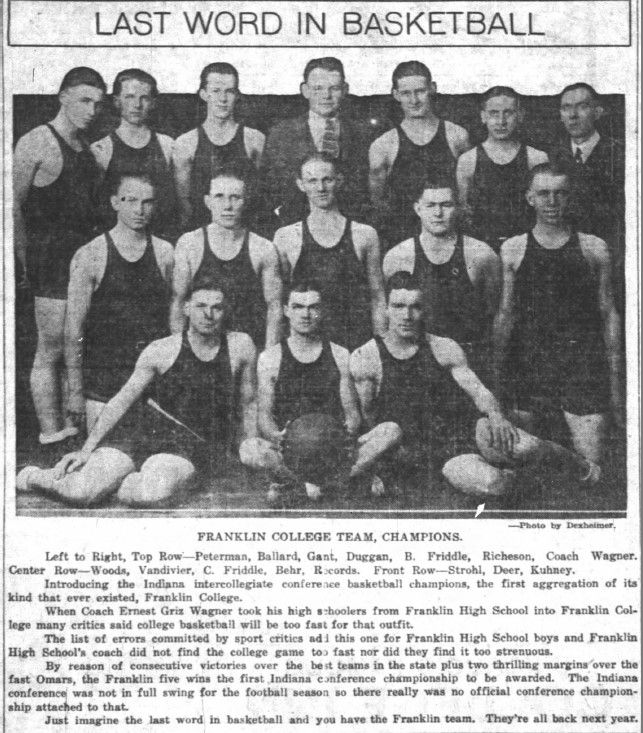
By January 11, 1923, the Indianapolis News reported that:
Franklin College seems to have a world championship basketball team. This assertion may be made advisedly for basketball reaches its greatest state of perfection in Indiana and there is no team now playing in the state that appears to be able to conquer the Franklin five.
Twice that season, the team defeated the Indianapolis Omars, an independent professional team that many considered to be among the best in the Midwest. [15] These victories earned them further clout. Franklin College lost only once during the season, to Indiana University in December 1922. However, because IU refused to waive its rule preventing freshmen from playing in the game (as such, none of Coach Wagner’s former championship team could compete), the game is often omitted from Wonder Five history. [16] On Thursday, March 1, Franklin defeated Butler to secure the best record in the state and thus claim the 1923 state collegiate title. [17]
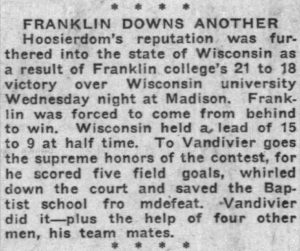
Franklin maintained a highly competitive schedule during the 1923-1924 season, playing and defeating the likes of Wisconsin, Marquette, and Notre Dame. The team lost just one game of the season, to Butler, and clinched their second consecutive state collegiate title in March 1924. [18]
There is only one team of any sort in the world that can’t lose. That is the Franklin College basketball team. When DePauw failed, why should others try? This machine is the nearest approach to perpetual motion that scientists have found and it seems not to be affected by flood, famine, or fate. – Muncie Star Press, February 10, 1924, 13.
Injuries and ineligible players hurt the team’s chances in 1925 and 1926 and Franklin fell short of the state title both years. Although the Wonder Five era had come to an end, the team’s legacy endured. Many players later coached basketball, imparting on other young men the skills they had learned under Coach Wagner. In 1962, Wagner and Vandivier were among the five charter members inducted into the Indiana Basketball Hall of Fame. John Gant was inducted five years later in 1967 and Burl Friddle (half brother of Carlyle Friddle) in 1969. Vandivier was also enshrined in the Naismith Hall of Fame in 1975. [19] Even more important than individual honors though was the team’s impact, both on the town of Franklin and on Indiana basketball in general. For years they brought Franklin residents together and turned the state’s attention towards the small town. They had set a new bar for the quality of play that other teams would continually try to match for years to come.
Footnotes:
Note: All newspaper articles accessed via Newspapers.com.
[1] Phillip Ellett, The Franklin Wonder Five: A Complete History of the Legendary Basketball Team (RLE Enterprises, Inc., 1986), 1-2.
[2] “Shortridge Loses Again,” Indianapolis Star, January 23, 1919, 15.
[3] “Franklin Lost 18-16,” Franklin Evening Star, March 14, 1919, 1.
[4] “Franklin High Looms Up,” Indianapolis News, November 13, 1919, 25.
[5] Ibid.; “Rushville Easy for Franklin,” Franklin Evening Star, December 13, 1919, 2; “South Gains Comment for Splendid Playing,” Indianapolis News, January 26, 1920, 16.
[6] “Franklin Trounces Jefferson, 31 to 13, for State Net Title,” Indianapolis Star, March 14, 1920, 26.
[7] “Franklin Coach Awarded Purse,” Columbus Republic, March 18, 1920, 6.
[8] “Big Game at the Gym Friday Night,” Martinsville Reporter-Times, December 16, 1920, 1.
[9] Ellett, 58-59.
[10] “New Gym for Franklin,” Muncie Star Press, March 6, 1921, 15.
[11] “Franklin Defeats Anderson for Title, 35-22,” Indianapolis Star, March 20, 1921.
[12] “Franklin Does Honor to Quintet Champion,” Richmond Palladium-Item, March 22, 1921, 11.
[13] “Want County to Nail Three Championships,” Franklin Evening Star, December 3, 1921, 1.
[14] “Franklin High School Wins Title for Third Time,” Indianapolis Star, March 19, 1922, 25.
[15] “Vandivier Shines in 32-31 Victory,” Indianapolis Star, January 18, 1923, 10.
[16] “Local Freshmen Barred in I.U.-Franklin Game,” Franklin Evening Star, November 18, 1922, 1; “Baptists Defeat Omars, 36 to 29, in Last Half Rally,” Indianapolis Star, February 2, 1923, 13.
[17] “Franklin College Wins State Championship,” Franklin Evening Star, March 2, 1923, 1. Some sources claim that by winning the state championship, Franklin College was also the national champion during this period. Because the NCAA tournament did not start until 1939 and there was no other official national tournament at this time, it is difficult to definitively claim Franklin as the national champion. In fact, other schools like Kansas also try to lay claim to the “national” 1922 title. For more information about this, see Zach Miller’s “What Constitutes A Basketball Championship? Don’t Ask Kansas,” The Missourian, March 6, 2012.
[18] “Franklin Wins State Title,” Franklin Evening Star, March 5, 1924, 1.
[19] Details about the Wonder Five players is limited in this post due to space constraints. For more information on the players, specific games, and fan reactions, see “Franklin Wonder Five,” Marker File, #41.2020.1, Indiana Historical Bureau or Ellett’s The Franklin Wonder Five.


